American Kestrel
- December 17, 2023
- 0 comment
The American Kestrel(Falco sparverius) is a small and colorful falcon native to North and South America. It is the smallest falcon in North America and is easily identifiable by its distinctive plumage. The male American Kestrel typically has blue-gray wings and a rusty-colored back with black spots. The female, on the other hand, often has a more extensive pattern of rusty coloration on her wings and back.
Physical Appearance

American Kestrel
- Lifespan: 5-8 years
- Habitat: Deciduous and mixed deciduous-evergreen forests
- Diet: Insects, such as caterpillars, beetles, and butterflies, Also eats fruits, berries, and seeds
- Size: 17-20 cm
- Weight: 26-37 grams
- Wingspan: 28-33 cm
- Conservation Status: Least Concern
- Population Trend: Population Stable
Known for its hovering hunting technique, the American Kestrel can often be observed in open habitats such as grasslands, meadows, and along roadsides. Its diet mainly consists of small mammals, insects, and birds, making it an adaptable and opportunistic predator.
Species Type of American Kestrel
The American Kestrel (Falco sparverius) belongs to the Falconidae family, which includes various falcons and caracaras. Within the genus Falco, the American Kestrel is a member of the subgenus Dissodectes. It is a small, diurnal bird of prey and is further classified into several subspecies based on regional variations in its appearance and distribution. The taxonomy of the American Kestrel reflects its diverse adaptations to different habitats across North and South America.
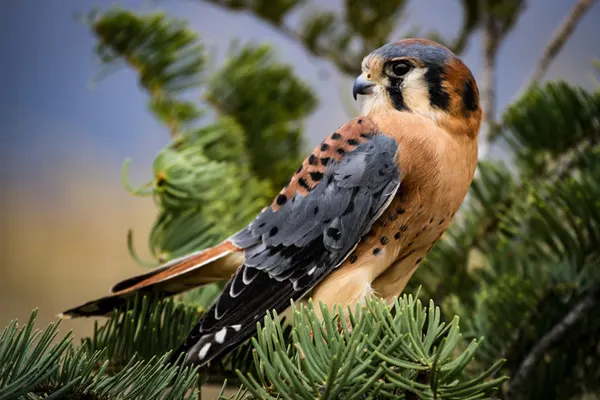

The American Kestrel’s ability to adapt to diverse environments, resulting in slight variations in appearance across its range. Taxonomic classifications are essential not only for scientific understanding but also for conservation efforts aimed at preserving the genetic diversity and ecological roles of different populations within the species.
Feather Coloration of American Kestrel
These colorations serve practical purposes in the bird’s life, such as camouflage during perching and hunting, as well as communication and mate attraction during the breeding season. The intricate patterns and hues not only make the American Kestrel visually stunning but also aid in its survival in diverse habitats, ranging from open grasslands to urban environments. The variability in coloration is also influenced by regional adaptations, leading to the recognition of different subspecies within the American Kestrel.
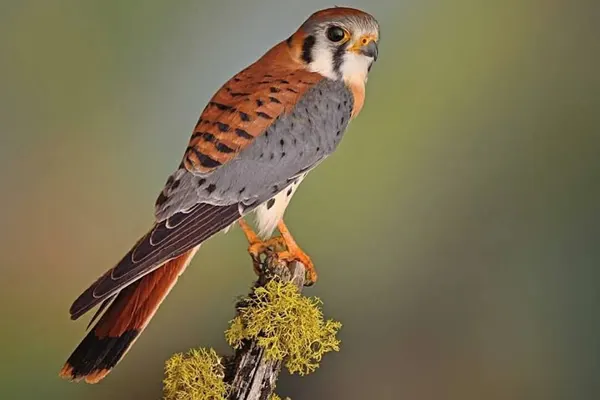
Male
- Slate-blue head and wings contrasting sharply with a rusty-red back and tail.
- Black terminal band on the tail.
- Pale undersides with brown and gray spots.
- Black “sideburns” creating a distinctive facial pattern.
Female
- Warmer, reddish wings, back, and tail with brown streaks (not solid rusty-red like males).
- Black markings less pronounced than in males.
- Pale undersides similar to males.

The variability in feather coloration is not only a result of gender differences but can also be influenced by geographic location, leading to the recognition of different subspecies. This adaptability in coloration has contributed to the success of the American Kestrel in a wide range of habitats across North and South America.
Flight Characteristics of American Kestrel
The flight characteristics of the American Kestrel are a remarkable adaptation that allows them to be successful predators. Their agility, speed, stamina, and ability to adapt to different flight conditions make them marvels of the avian world.
- Hovering Ability: One of the most distinctive flight behaviors of the American Kestrel is its ability to hover in mid-air. This is particularly useful during hunting, allowing the kestrel to remain stationary in the air while scanning the ground for prey.
- Swift and Acrobatic Flight: American Kestrels are known for their swift and acrobatic flight. They are capable of rapid maneuvers, including sharp turns and dives, which are essential for capturing agile prey such as insects and small birds.
- Gliding and Soaring: While hunting, American Kestrels often utilize a combination of gliding and soaring. They can ride air currents efficiently, conserving energy as they search for prey over open landscapes.

- Low-Level Hunting: The kestrel is frequently observed flying close to the ground during hunting, utilizing its keen eyesight to spot potential prey items such as rodents and insects.
- Adaptability to Urban Environments: American Kestrels have demonstrated adaptability to urban environments, utilizing structures like utility poles and buildings as perches for hunting and nesting. Their flight patterns may include navigating through complex urban landscapes with ease.
- Territorial Flight Displays: During the breeding season, both males and females engage in territorial flight displays. These displays involve aerial acrobatics, with the birds performing loops, rolls, and other maneuvers to establish and defend their territories.
The combination of hovering, swift flight, and adaptability to various environments makes the American Kestrel a highly successful and versatile predator. These flight characteristics are crucial adaptations that contribute to the bird’s ability to thrive in diverse habitats across the Americas.
Migration Patterns of American Kestrel
The American Kestrel, a small falcon native to North America, exhibits fascinating migration patterns. These journeys, undertaken by millions of kestrels annually, showcase their remarkable adaptations and highlight the interconnectedness of ecosystems.
- Partial Migrants: American Kestrels are considered partial migrants, meaning that only certain populations migrate, while others remain in their breeding areas throughout the year.
- Migration Routes: Migratory American Kestrels typically follow established routes between their breeding grounds in North America and wintering areas in the southern parts of the continent, Central America, and even as far south as South America.
- Altitudinal and Latitudinal Migration: Migration can involve both altitudinal and latitudinal movements. Some kestrels migrate vertically by descending from higher elevations to lower ones, while others migrate horizontally across latitudes.

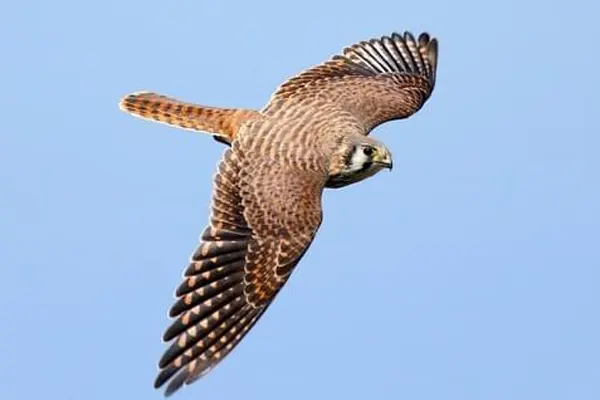

- Seasonal Timing:
- The timing of migration varies among populations and regions. In general, northern populations tend to migrate southward during the fall to escape harsh winter conditions, while some southern populations may exhibit shorter-distance or altitudinal migrations.
- Urban and Agricultural Habitats:
- American Kestrels are known for their adaptability to various environments, including urban and agricultural landscapes. This adaptability may influence their migration patterns, as they can find suitable prey and nesting sites in a variety of areas.
- Individual Variation:
- There can be considerable individual variation in migration behavior. Some American Kestrels within the same population may migrate, while others remain resident. This flexibility in migration strategies contributes to the species’ overall resilience.
The American Kestrel’s migration patterns offer a glimpse into the remarkable adaptations and ecological importance of this fascinating avian species. By understanding their journeys, we gain a deeper appreciation for the interconnectedness of the natural world and the vital role that kestrels play in maintaining healthy ecosystems.
Habitat & Distribution of American Kestrel
The diverse habitats and distribution of the American Kestrel, we can appreciate their remarkable adaptability and recognize the importance of protecting their natural environment. Continued conservation efforts are crucial to ensure the survival and thriving of this fascinating falcon species for generations to come.
- Habitat: American Kestrels occupy a variety of habitats, ranging from open grasslands and meadows to urban areas. They are commonly found in agricultural landscapes, along highways, and in areas with scattered trees or utility poles that provide perching and hunting vantage points.
- Open Country: The kestrel thrives in open country environments, including fields, deserts, and savannas. These habitats offer ample opportunities for hunting small mammals, birds, and insects, which constitute the kestrel’s diet.
- Adaptability to Urban Environments: One notable feature of the American Kestrel is its ability to adapt to urban and suburban environments. They are often observed perching on buildings, streetlights, and other man-made structures. Some kestrels even nest in urban areas, utilizing buildings for shelter.
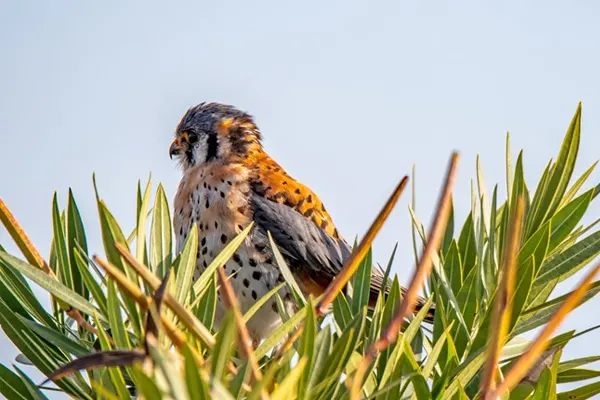
- Nesting Sites: American Kestrels nest in cavities, and they may use natural sites such as tree hollows or cliffs. However, they are known for their adaptability in selecting nesting locations, including artificial sites like abandoned buildings, nest boxes, and tree cavities.
- Distribution: The American Kestrel has a wide distribution that spans North and South America. In North America, it is found from the Arctic tundra to Central America. In South America, its range extends to parts of Colombia, Venezuela, and Ecuador.
- Seasonal Movements: Some populations of American Kestrels are sedentary, residing in their breeding territories year-round. Others undertake seasonal movements or migrations, with northern populations often moving south during the winter to escape colder conditions.
The adaptability of the American Kestrel to various habitats and its ability to thrive in both natural and human-altered landscapes contributes to successful conservation strategies for this species. Conservation efforts focus on protecting suitable nesting sites, preserving open habitats, and mitigating potential threats such as habitat loss and pesticide exposure.
Behavioral Traits of American Kestrel
The American Kestrel (Falco sparverius) exhibits a range of interesting behavioral traits that contribute to its success as a predator and its ability to thrive in diverse environments.
- Territorial Behavior: American Kestrels are territorial birds, especially during the breeding season. They engage in aerial displays and vocalizations to establish and defend their territories, with both males and females participating in these behaviors.
- Hunting Techniques: Kestrels are skilled hunters and primarily feed on small mammals, insects, and birds. They employ a sit-and-wait hunting strategy, perching on vantage points and scanning the surroundings for prey. Their exceptional eyesight allows them to spot potential prey from a considerable distance.
- Hovering: One of the distinctive behaviors of the American Kestrel is its ability to hover in mid-air while hunting. This hovering technique, often observed during the bird’s search for prey, is facilitated by rapid wing beats and helps them target prey on the ground.
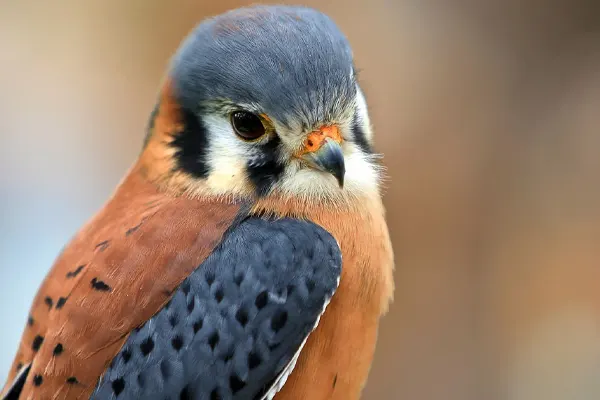
- Nesting and Courtship: During the breeding season, courtship displays involve aerial acrobatics, with the male performing loops, dives, and other maneuvers to attract the female. Kestrels often use cavities in trees, cliffs, or man-made structures for nesting.
- Communication: American Kestrels communicate using a variety of vocalizations, including calls that serve different purposes. Vocalizations may be used for territory defense, courtship, or communication between mates and offspring.
- Adaptability to Urban Environments: These birds are highly adaptable to human-altered landscapes. They often perch on buildings, utility poles, and other structures in urban and suburban areas. Some kestrels even nest in man-made structures such as abandoned buildings or nest boxes.
- Parental Care: Both male and female American Kestrels participate in raising their young. They cooperate in building nests, incubating eggs, and feeding the chicks. The young kestrels fledge and become independent but may continue to receive parental care for some time.
The diverse behavioral repertoire of the American Kestrel reflects their remarkable adaptations to their environment. Their hunting strategies, social interactions, and courtship rituals offer fascinating insights into their lives and contribute to their continued success as a thriving species.
Role in Ecosystem of American Kestrel
The American Kestrel, though small in size, plays a vital role in maintaining the balance and health of various ecosystems. Their diverse diet and predatory behaviors have a significant impact on populations of other species, making them integral to the ecological web.
- Control of Pest Populations: As a raptor, the American Kestrel is a natural predator of insects, small mammals, and birds. By hunting small rodents and insects, particularly those considered agricultural pests, kestrels help control population numbers of potentially damaging species. This contributes to the overall health of ecosystems and can be beneficial for farmers and other human activities.
- Top Predator in the Food Chain: As an apex predator within its size range, the American Kestrel occupies an important position in the food chain. This means that it helps regulate the populations of species it preys upon, preventing overpopulation of certain prey species that could have cascading effects on vegetation and other parts of the ecosystem.

- Indicator of Ecosystem Health: The presence and behavior of American Kestrels can serve as indicators of ecosystem health. These birds are sensitive to environmental changes, and their population status can reflect the overall well-being of the ecosystems they inhabit. Monitoring kestrel populations can provide insights into the impacts of habitat alterations, climate change, and other ecological factors.
Preserving the populations and habitats of American Kestrels is crucial for maintaining healthy ecosystems. Conservation efforts focused on protecting nesting sites, mitigating threats such as habitat loss and pesticide exposure, and promoting sustainable land management practices contribute to the continued role of American Kestrels in maintaining ecological balance.
Dietary Habits of American Kestrel
The dietary habits of the American Kestrel are a testament to their adaptability and effectiveness as predators. Their diverse diet, hunting strategies, and physical adaptations allow them to thrive in various ecosystems and contribute to the overall balance of the natural world.
- Insects: Insects constitute a significant portion of the American Kestrel’s diet. They feed on grasshoppers, beetles, dragonflies, moths, and other flying and ground-dwelling insects. The kestrel’s aerial agility allows it to capture insects in flight during hovering or rapid pursuit.
- Small Mammals: Small mammals are a common prey item for American Kestrels. They hunt rodents such as voles, mice, and shrews. The kestrel’s keen eyesight enables it to spot movement on the ground, facilitating successful hunting of these small mammals.
- Birds: American Kestrels are opportunistic hunters of small birds. They may capture sparrows, finches, swallows, and other small avian species. Kestrels use their speed and agility to pursue and catch birds in flight.


- Reptiles and Amphibians: Occasionally, American Kestrels prey on reptiles and amphibians. They may catch lizards, frogs, and small snakes, particularly in areas where these prey items are abundant.
- Earthworms and Other Invertebrates: In addition to larger prey items, American Kestrels may also consume earthworms and various other invertebrates. This flexibility in diet allows them to exploit a wide range of food sources based on availability.
- Dietary Adaptations: The kestrel’s diet can vary based on regional and seasonal availability of prey. They exhibit adaptability, adjusting their hunting strategies and prey preferences according to the specific ecosystems they inhabit.
- Scavenging: American Kestrels may engage in scavenging, especially in urban and suburban areas. They might feed on roadkill or take advantage of discarded food items, showcasing their ability to adapt to human-altered landscapes.
The varied diet of the American Kestrel reflects its opportunistic nature and adaptability to different habitats. Their role as predators helps regulate the populations of insects and small mammals, contributing to the overall balance of ecosystems. Conservation efforts that consider the availability of suitable prey and maintain diverse habitats are essential for supporting the dietary needs of American Kestrels.
Interesting Facts of American Kestrel
- Smallest North American Falcon: The American Kestrel holds the title of being the smallest falcon in North America. Despite its small size, it is a formidable and skilled predator.
- Sexual Dimorphism in Plumage: Male and female American Kestrels exhibit distinct differences in plumage. Males typically have slate-blue heads, while females have more extensive rusty coloration on their wings and backs. This sexual dimorphism is not common among raptors.
- Hovering Hunting Technique: One of the unique behaviors of the American Kestrel is its ability to hover in mid-air while hunting. This hovering technique is employed to spot and catch prey on the ground, showcasing the bird’s agility in flight.
- Varied Vocalizations: American Kestrels are known for their diverse vocalizations, including high-pitched whistles and calls. These vocalizations serve purposes such as communication between mates, territorial defense, and during courtship displays.
- Adaptability to Urban Environments: Unlike some raptors, American Kestrels are highly adaptable to urban and suburban environments. They are frequently observed perching on buildings, streetlights, and other structures, and may even nest in man-made structures.
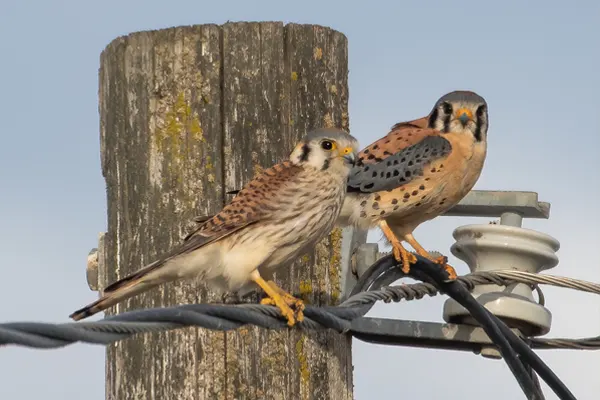
- Nesting in Cavities: American Kestrels typically nest in cavities, but they are versatile in choosing nesting sites. They may use tree hollows, cliffs, or even man-made structures such as abandoned buildings and nest boxes.
- Partial Migrator: While some populations of American Kestrels are sedentary and remain in their breeding territories year-round, others undertake seasonal migrations. This partial migratory behavior varies across different regions.
- Fast and Agile Fliers: American Kestrels are known for their swift and acrobatic flight. They can execute rapid turns, dives, and other maneuvers, making them highly effective hunters, especially when pursuing agile prey.
- Distinctive Hunting Perches: When hunting, American Kestrels often use prominent perches such as utility poles, fence posts, or tree limbs. These perches provide an elevated vantage point for spotting prey and planning hunting strategies.
Nesting Habits of American Kestrel
The nesting habits of the American Kestrel allows us to appreciate their adaptability and resilience. Recognizing the threats they face and taking action to protect their nesting sites is essential for ensuring the survival of this fascinating species.
Nesting Sites
- Cavity nesters: Kestrels are cavity nesters, meaning they rely on existing cavities for nesting. They readily utilize abandoned woodpecker holes, natural tree hollows, rock crevices, and even man-made structures like bird boxes.
- No nest building: Unlike many other birds, kestrels do not build their own nests. Instead, they simply scrape out a shallow depression in the floor of the cavity.
- Adapting to different locations: Kestrels are not picky about the location of their nests and can be found nesting in trees, cliffs, buildings, and even abandoned nests of other birds.
Nesting Season
- Timing: The kestrel’s nesting season varies depending on geographical location, but it typically occurs between March and August.
- Clutch size: Kestrels typically lay 4-6 eggs, which are incubated by both parents for about 28-30 days.
- Fledging: Young kestrels fledge around 25-30 days after hatching and become independent shortly thereafter.
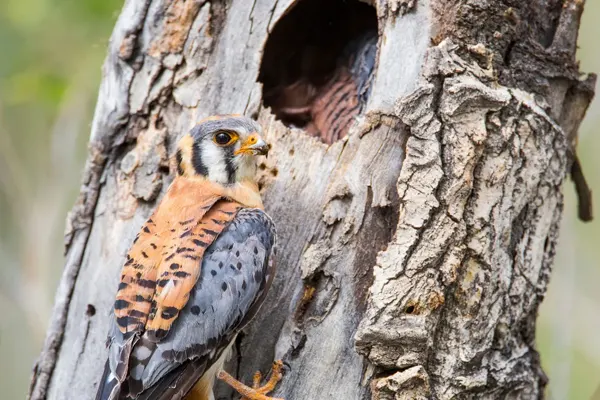
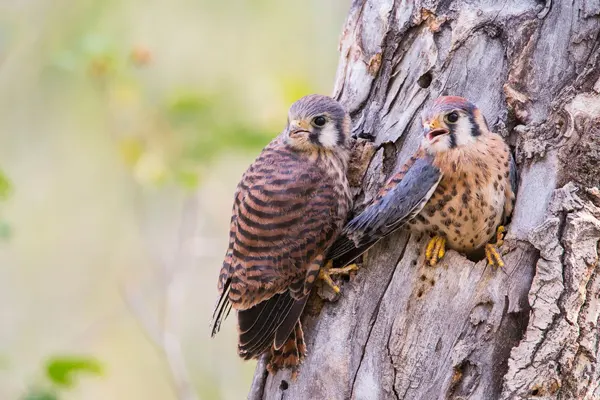
Parental Care
- Shared responsibility: Both parents share the responsibility of incubating the eggs and raising the young. They take turns hunting for food and feeding the chicks.
- Protecting the nest: Kestrels are fiercely protective of their nests and will readily attack potential predators, including other birds, snakes, and mammals.
- Multiple broods: Kestrels may raise two or even three broods in a single season, depending on food availability and other factors.
Adaptations and Strategies
- Reusing nests: Kestrels often reuse the same nest year after year, saving them time and energy.
- Camouflage: The female kestrel’s brown plumage provides camouflage for the nest, making it less visible to predators.
- Shifting nesting locations: Kestrels are adaptable and may shift their nesting locations in response to changes in their environment, such as habitat loss or disturbance.
The nesting habits of American Kestrels is essential for conservation efforts. Providing suitable nesting sites, whether natural or artificial, contributes to the success and well-being of kestrel populations. Conservation initiatives often involve installing and maintaining nest boxes to support kestrel breeding in areas where natural cavities are limited.
Calls & Vocalizations of American Kestrel
The American Kestrel, a small yet vocal falcon, uses a diverse range of calls and vocalizations to communicate. These sounds offer insights into their behavior, emotions, and intentions, providing a glimpse into their fascinating world.
Common Vocalizations
- Klee-klee-klee: This loud, excited series of 3-6 “klee!” or “killy!” notes is the most common vocalization of the American Kestrel. It is used in various contexts, including territorial defense, courtship, and alarm calls.
- Whine: A long, drawn-out whine lasting 1-2 minutes is used primarily by kestrels during courtship and while feeding fledglings.
- Chitter: A rapid, high-pitched chattering sound is used by both sexes in friendly interactions, such as greeting each other or when parents reunite with their young.
- Scold: A harsh, scolding call is used to warn off intruders or potential predators from their territory or nest.
- Screaming: A high-pitched, piercing scream is used during distress or when defending themselves against potential threats.
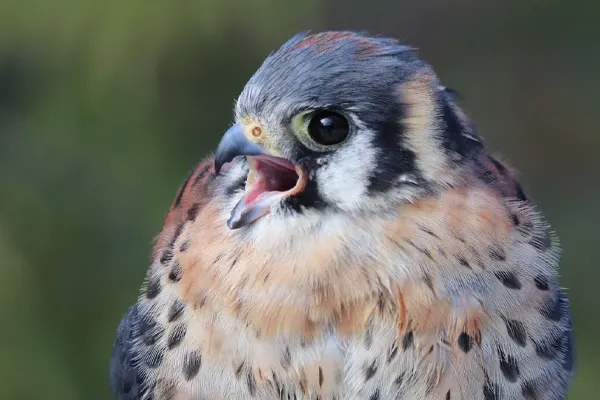
Functions and Significance
- Territorial defense: Vocalizations play a crucial role in territorial defense, allowing kestrels to warn off intruders and establish their dominance over a specific area.
- Courtship and mating: Specific calls are used during courtship to attract mates and establish pair bonds.
- Communication with young: Parents use vocalizations to communicate with their young, guiding them to food sources and warning them of potential dangers.
- Social interactions: Vocalizations facilitate communication between individuals, allowing them to maintain social bonds and exchange information.
- Survival: Vocalizations play a vital role in survival by alerting kestrels to potential threats and enabling them to coordinate hunting and other activities.
The calls and vocalizations of the American Kestrel allows us to appreciate their complex communication system and gain insights into their social behavior and ecological role. By learning to recognize and interpret these sounds, we can develop a deeper appreciation for this fascinating avian species.
Conservation Status of American Kestrel
The American Kestrel, once a widespread and abundant falcon in North America, faces several challenges that have led to population declines in recent decades. While not currently listed as endangered or threatened, their conservation status is a cause for concern.
- Declining populations: Studies indicate an overall decline of approximately 53% in the American Kestrel population between 1966 and 2019.
- Regional variations: The rate of decline varies across different regions, with some populations being more heavily impacted than others.
- Habitat loss: The primary threat to kestrels is habitat loss, particularly the loss of open spaces like grasslands, meadows, and farmland.
- Pesticide use: Pesticides can accumulate in the food chain and harm kestrels and their prey, leading to population declines.
- Climate change: Changing weather patterns and temperature fluctuations can affect kestrel prey availability and nesting success.
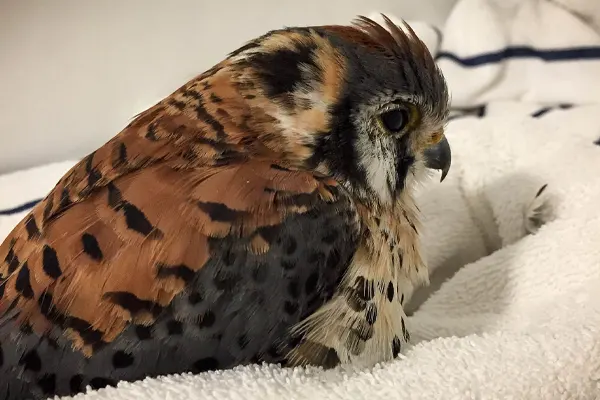
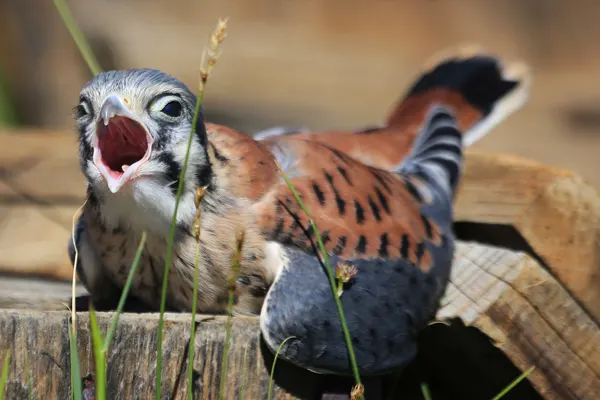
- Nesting Site Protection: Providing and maintaining suitable nesting sites, such as nest boxes, helps support kestrel breeding success, especially in areas where natural cavities are limited.
- Habitat Preservation: Preserving open landscapes and natural habitats ensures that kestrels have access to suitable hunting grounds and nesting sites.
The conservation status of the American Kestrel is complex and can vary depending on the specific population and region. While some populations are doing well, others are experiencing significant declines. Continued vigilance and conservation efforts are crucial for ensuring the long-term survival of this iconic falcon.
Research and Ongoing Studies of American Kestrel
Focus on various aspects of its biology, behavior, ecology, and conservation. Research efforts contribute to a better understanding of this species and inform conservation strategies.
- Population Dynamics: Researchers study the population dynamics of American Kestrels, including factors influencing population size, distribution, and breeding success. Long-term monitoring helps assess trends and identify potential threats.
- Migration Patterns: Migration patterns of American Kestrels are of interest, especially regarding the timing, routes, and distances traveled by different populations. Tracking studies, including the use of satellite telemetry and banding, provide insights into their migratory behaviors.
- Breeding Ecology: Studies on breeding ecology explore nesting habits, reproductive success, and factors affecting nest site selection. Research may also investigate the impact of climate change on breeding phenology and success.

- Urban Adaptation: Given the adaptability of American Kestrels to urban environments, studies focus on their behavior in urban landscapes, including nesting preferences, foraging habits, and the impact of urbanization on their overall ecology.
- Genetic Studies: Genetic research helps understand the genetic diversity and population structure of American Kestrels. This information is valuable for conservation genetics and assessing the health of different populations.
- Pesticide Exposure: Investigations into the effects of pesticides on American Kestrels aim to understand potential threats and the impact of contaminants on their health and reproductive success.
- Conservation Strategies: Ongoing studies contribute to the development of effective conservation strategies. This includes identifying key habitat requirements, addressing threats, and evaluating the success of conservation initiatives, such as the installation of nest boxes.
Ongoing studies contribute not only to scientific knowledge but also to the development of effective conservation measures aimed at ensuring the continued well-being of this adaptable bird of prey.
Educational and Ecotourism of American Kestrel
The American Kestrel, with its captivating beauty, fascinating behavior, and ecological significance, holds immense educational and ecotourism potential. By engaging the public through various avenues, we can foster appreciation for this remarkable species and promote its conservation.
- School visits and presentations: Educating children about kestrels through interactive programs can instill a sense of wonder for nature and inspire future conservationists.
- Citizen science initiatives: Engaging the public in data collection, nest monitoring, and other research activities can provide valuable insights into kestrel populations and engage communities in conservation efforts.
- Educational materials and online resources: Developing informative websites, brochures, and educational videos can increase public awareness about kestrels and their ecological importance.
- Museum exhibits and interactive displays: Engaging exhibits showcasing kestrel adaptations, hunting strategies, and conservation needs can educate visitors and encourage appreciation for these falcons.
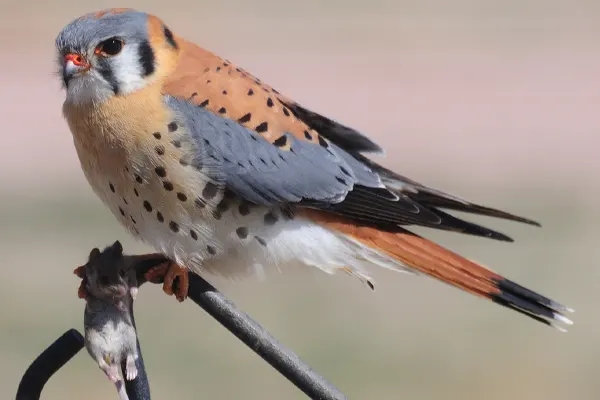
Ecotourism Opportunities
- Birdwatching tours and guided hikes: Leading tours specifically focused on observing kestrels in their natural habitat can provide an immersive and educational experience for nature enthusiasts.
- Wildlife photography workshops: Offering workshops focused on capturing images of kestrels can attract photographers and promote responsible wildlife observation practices.
- Kestrel banding demonstrations: Witnessing the banding process can educate visitors about research methods and the importance of tracking kestrel populations.
- Volunteer programs: Engaging volunteers in habitat restoration, nest box maintenance, and educational outreach can contribute to kestrel conservation and provide valuable learning opportunities.
The educational and ecotourism potential of the American Kestrel, we can foster a deeper connection between people and nature. Through engaging programs, responsible tourism practices, and effective communication, we can cultivate a generation of informed and passionate individuals who will contribute to the long-term survival of this remarkable species.
Conclusion
The American Kestrel, a small raptor with a mighty spirit, embodies resilience and adaptability. Their remarkable diversity in habitat preferences, hunting strategies, and communication methods reflects their remarkable evolutionary success.
Despite facing challenges like habitat loss and pesticide use, the American Kestrel continues to inspire and captivate us. Their presence serves as a reminder of the intricate balance of the natural world and the importance of conservation efforts.
Through ongoing research, educational initiatives, and responsible ecotourism, we can ensure the future of the American Kestrel. By appreciating their ecological significance and engaging in conservation efforts, we can ensure that future generations can continue to marvel at this magnificent falcon soaring through the skies.



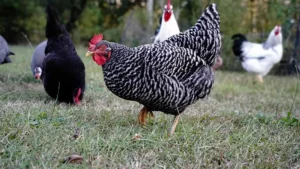

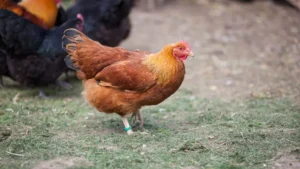
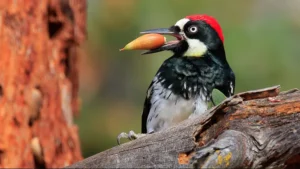
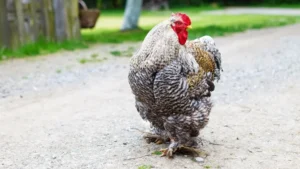
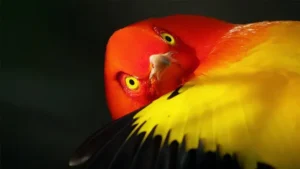
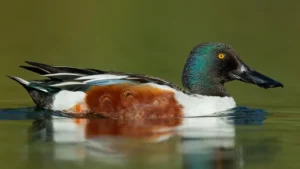
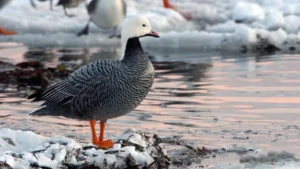
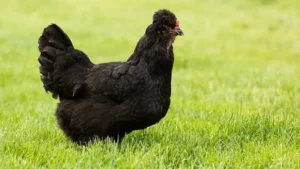
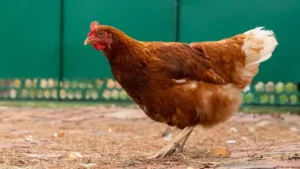
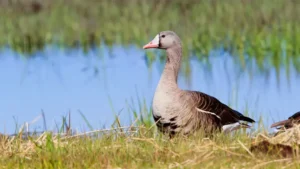
Leave your comment